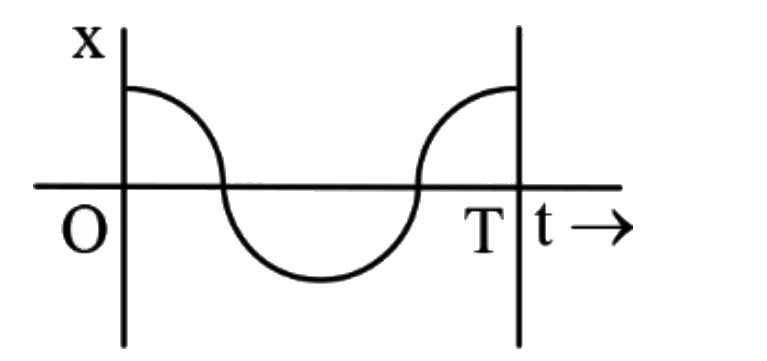A simple harmonic motion has an amplitude A and time period T. What is the time taken to travel from x=A to x=A/2?
To solve the problem of finding the time taken for a particle in simple harmonic motion (SHM) to travel from x=A to x=A2, we can follow these steps:
Step 1: Understand the SHM Equation
The displacement x of a particle in SHM can be described by the equation:
x(t)=Acos(ωt)
where:
- A is the amplitude,
- ω is the angular frequency, and
- t is the time.
Step 2: Determine Angular Frequency
The angular frequency ω is related to the time period T by the formula:
ω=2πT
Step 3: Set Up the Displacement Equations
We need to find the time taken to go from x=A to x=A2.
1. At x=A:
A=Acos(ωt1)⟹cos(ωt1)=1⟹t1=0
(This is the starting point, where the particle is at maximum displacement.)
2. At x=A2:
A2=Acos(ωt2)⟹cos(ωt2)=12
The angle whose cosine is 12 is π3 radians (or 60 degrees).
Step 4: Solve for Time t2
From the equation cos(ωt2)=12:
ωt2=π3⟹t2=π3ω
Substituting ω=2πT:
t2=π3⋅2πT=T6
Step 5: Calculate the Time Taken
Since we found t1=0 and t2=T6, the time taken to travel from x=A to x=A2 is:
Δt=t2−t1=T6−0=T6
Final Answer
The time taken to travel from x=A to x=A2 is:
T6
The displacement x of a particle in SHM can be described by the equation:
x(t)=Acos(ωt)
where:
- A is the amplitude,
- ω is the angular frequency, and
- t is the time.
The angular frequency ω is related to the time period T by the formula:
ω=2πT
We need to find the time taken to go from x=A to x=A2.
A=Acos(ωt1)⟹cos(ωt1)=1⟹t1=0
(This is the starting point, where the particle is at maximum displacement.)
A2=Acos(ωt2)⟹cos(ωt2)=12
The angle whose cosine is 12 is π3 radians (or 60 degrees).
From the equation cos(ωt2)=12:
ωt2=π3⟹t2=π3ω
Substituting ω=2πT:
t2=π3⋅2πT=T6
Since we found t1=0 and t2=T6, the time taken to travel from x=A to x=A2 is:
Δt=t2−t1=T6−0=T6
The time taken to travel from x=A to x=A2 is:
T6
Topper's Solved these Questions
- BOOK - SL ARORACHAPTER - OSCILLATIONSEXERCISE - Problems for self practice67videos
OSCILLATIONS
- BOOK - SL ARORACHAPTER - OSCILLATIONSEXERCISE - Exercise233videos
OSCILLATIONS
- BOOK - SL ARORACHAPTER - OSCILLATIONSEXERCISE - Example202videos
OSCILLATIONS
- BOOK - SL ARORACHAPTER - MOTION IN ONE DIMENSIONEXERCISE - problems for self practice66videos
MOTION IN ONE DIMENSION
- BOOK - SL ARORACHAPTER - Physical worldEXERCISE - Exercise49videos
Physical world
Similar Questions
Knowledge Check
- Question 1 - Select One
A simple harmonic oscillation has an amplitude A and time period T. The time required to travel from x=A to x=A2 is
AT6BT4CT3DT12 - Question 2 - Select One
A simple harmonic motino has amplitude A and time period T. The maxmum velocity will be
A4ATB2ATC2π√ATD2πAT - Question 3 - Select One
A particle is executing simple harmonic motion with an amplitude A and time period T. The displacement of the particles after 2T period from its initial position is
AAB4AC8ADzero
A particle is perfroming simple harmoic motion along x−axis with amplitude 4 cm and time period 1.2sec.The minimum time taken by the particle to move from x=2 cm to x=+4cm and back again is given by
View SolutionA body is performing simple harmonic motion of amplitude A and time period T. The figure shown position-time graph of the body . At any time t, acceleration of the body is f, then which of the following graphs is/are appropriate?
 View Solution
View SolutionThe equation of a simple harmonic motion (amplitude 5 cm and time period 0.5 second) is
View SolutionA particle executing simple harmonic motion with an amplitude 5 cm and a time period 0.2 s. the velocity and acceleration of the particle when the displacement is 5 cm is
View SolutionA simple pendulum performs simple harmonic motion about x=0 with an amplitude a ans time period T. The speed of the pendulum at x=a2 will be
View Solution

